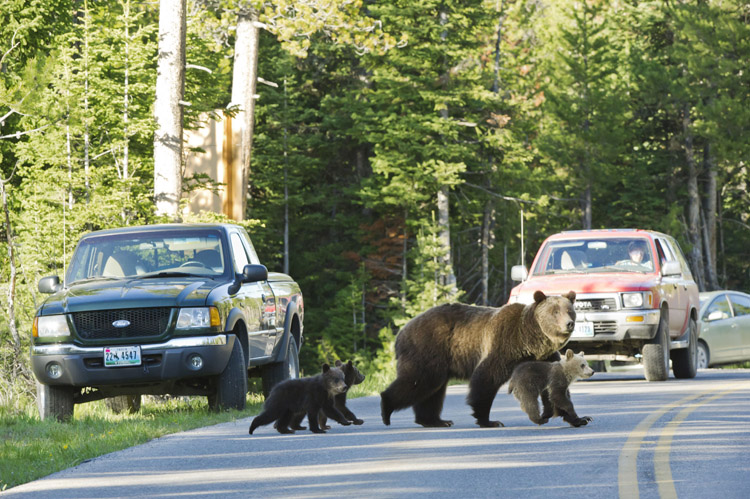CHEYENNE, Wyo. — A grizzly bear clan famous for its frequent roadside appearances in Grand Teton National Park is keeping park rangers especially busy this summer tending to tourist critter jams.
The cubs are cute — no question about that — but a female grizzly with cubs happens to be one of the most dangerous animals in North America. And this Grand Teton clan has a history: One attacked a hiker; another was shot and killed by a hunter.
Biologists speculate the unusually camera-friendly behavior by Grizzly No. 399 and her daughter, No. 610, might serve to keep at bay adult male grizzlies, which sometimes kill cubs not their own. Five spunky cubs recently have joined the clan, adding to the tourist traffic.
“It’s very important for people to remember that these are wild bears and that they are very protective,” said Steve Cain, senior wildlife biologist at Grand Teton.
No. 399 has attacked before. In 2007, the year after she gave birth to a litter of three cubs, she bit a man who came across the four bears feeding on a just-killed elk.
This year, three more cubs were born to No. 399 and two to No. 610, who has been especially visible in recent weeks.
Around sunset on a recent Sunday, No. 610 caused a traffic jam while feeding on an elk calf just 70 feet from a road. About 30 cars lined up while tourists snapped photos of the 5-year-old grizzly and her cubs. A team of rangers and volunteers made sure people stayed behind their cars and didn’t get too close.
June has been an especially busy for bear jams and the park’s Wildlife Brigade, a team of about a dozen volunteers supervised by a park ranger. The brigade also checks campgrounds for improperly stored food that could attract bears.
“I think this is going to be the summer of bear-watching in Grand Teton, the way it’s going,” said park spokeswoman Jackie Skaggs.
Grand Teton has not just famous grizzly bears, but more grizzlies in general as the big bruins rebound in the Yellowstone region, which is under federal protection as a threatened species. Numbers are up from a couple hundred in the 1970s to perhaps as many as 1,000 or more.
“Twenty years ago, seeing a grizzly in Grand Teton was rare. Today it’s common,” Cain said. “It’s necessitated a change in attitudes and culture.”
The park encourages people to take care not to attract grizzlies to camp and to know what to do if they encounter a grizzly: Use binoculars or long lenses for viewing; stay at least 300 feet away; and never get between an adult and its offspring, among other measures.
No. 610 — the bears are numbered in the order they’ve been trapped for study — has been frequenting the same area where she grew up, and biologists say she’s emulating her mother’s roadside habits.
Few people have observed the grizzlies as much as wildlife photographer Tom Mangelsen, who lives near the park and a short drive from the territories of No. 610 and No. 399.
He thinks the opportunity for one photo in particular is only a matter of time, possibly while elk are calving and attracting grizzlies to the Willow Flats area not far from Jackson Lake Lodge.
“The ideal thing for me would be to see if they walk past each other and see if they greet and meet each other. Typically females will tolerate other females, and even more so with their own offspring,” Mangelsen said.
Not all has been picture-perfect for No. 610’s two siblings.
Wildlife authorities in 2008 trapped male No. 587 at a home development in Jackson Hole and moved him west of the Teton Range. Last year they trapped him again in the Upper Green River Basin in an area where grizzlies had killed cattle. They moved him back to Grand Teton.
In 2009, a hunter killed No. 610’s sister, No. 615, not far from the park.
Prosecutors charged Stephen Westmoreland, of Teton Village, with illegally killing a grizzly. Westmoreland said he was covered in blood after gutting a deer and shot the bear from 40 yards out of fear she was about to attack. Hunters and bear advocates who debate whether people should defend against grizzlies with firearms or bear spray followed the trial closely.
A jury found Westmoreland guilty last year. A judge fined him $500; he had faced as much as a year in jail and a fine of $10,000.
Plenty of hunters encounter grizzlies in northwest Wyoming each fall. Wildlife managers relocate dozens every year to stop or prevent problems with people and property. Few grizzlies, though, have been as predictably visible at roadsides as these two moms and their cubs.
The theory that they’re protecting their offspring is reasonable, Cain said.
“On the other hand, I would say that we have seen males courting both of these females during the mating season in close proximity to roads. So we do know that males will occasionally tolerate people,” he said.
Either way, the big bears and their cubs are an extraordinary sight, even in a national park.
“We don’t have any other animals reach rock-star status,” Cain said.
Send questions/comments to the editors.


